Keywords
|
| FCC, ICNIRP, IEEE, ARM, GSM |
INTRODUCTION
|
| The Global System of Mobile Communication (GSM) is the most versatile mobile communication technology in the world. This technology makes use of an arrangement of sophisticated communication systems that work together within and out of a network service. |
| Over the years, mobile communication has evolved from the first generation (1G) to the fourth generation (4G) mobile systems. The small size, ease of use and sophistication of GSM mobile phones are the major reasons why it has dominated the telecom market around the world. At the current state of mobile phone deployment and the annual increase in the number of people that are using them, billions people are exposed to radiation from mobile phones around the world. |
| In some cities, mobile phone base stations (BTSs) are found almost at every 500 m interval to another, and others where there is no restriction on the location of the towers more than 30 cell towers can be seen within 1km (Sivani and Sudarsanam, 2012). Since more users are emerging every day, the proliferation of mobile Base Transceiver Station (BTS) or mast is of great concern (ARPANSA, 2000). The radiation emitted from the numerous antennas mounted on the mast of the cell sites are also of great concerns to the populace, especially people who lives close to them. Therefore, this paper aims at highlighting the important areas of environmental RF exposure assessment, ranging from its dosimetric quantities to methods or procedure used during assessments. |
RF Radiation Exposure Quantity and Units
|
| Radio frequency (RF) dosimetry describes how external RF electromagnetic fields (EMF) are absorbed and distributed in different organs of the body (Ahlbom et al., 2012). The basic quantities for estimating RF energy in a medium are the electric E (V/m) and magnetic B (A/m) field strength. These quantities are mostly assessed in the air and may be used to directly estimate the exposure to RF energy in a body. This does not give an accurate measure of the absorbed RF energy in the body, since it depends on the frequency of the field, and the size and orientation of the body. The power density S (W/m2) is another important quantity in RF exposure assessment that is often used in several studies and also as the main quantity for standard limits. Both E and H are directly related to power density by the equation (ICNIRP, 1998): |
CELLULAR BASE STATION TOWERS & RADIO FREQUENCIES
|
| There are many different types of base stations used by operator’s i.e. |
| (1) Macro cell, |
| (2) Micro cell, |
| (3) Pico cell. |
| The cellular base station towers are Categorization is based on the purpose of the site rather than in terms of technical constraints such as radiated power or antenna height. In India macro cellular base station provides the main infrastructure for a mobile phone network and their antennas are mounted at sufficient height to give them a clear view over the surrounding geographical area. |
| Micro cell base stations provide additional radio capacity where there are a high number of users such as in cities and towns. Micro antennas tend to be mounted on street level poles or external walls of existing buildings. The power of each base station transmitter is set to a level that allows a mobile phone to be used within an area for which the base station is designed to provide coverage. Higher powers are needed to cover larger cells. |
| The maximum power of individual macro cellular base station transmitter is 20 watts. For a low capacity base station with only one transmitter the radiated power does not vary over time. With larger capacity base stations having multiple transmitters the output power can vary over time and with the numbers of calls being handled. One of the transmitters will transmit continuously at full power, whereas other transmitter will transmitter will operate intermittently and with varying power levels up to the maximum. Micro cellular base stations tend to operate at lower power level around 2-3 watt and have fewer transmitters because of their smaller coverage area. |
IMPLEMENTATION OF EMBEDDED EMR MONITORING SYSTEM
|
| The receiving frequency range of the receiver antenna is in between 80 MHz to 2.5 GHz. In order to tune the particular frequency in the RF 2052, the Display section which consist of CDEEC-RF PC Client software (Visual Basic 2010), will select required center frequency and span (required Band width) and is fed to the ARM controller through USB cable. The ARM controller consists of Fractional-N algorithm method, which will convert the selected center frequency and span into its corresponding digital value and is fed to the RF 2052. Then, the RF 2052 will tune that frequency and fed to the Si 4362 and it will estimate the radiated power and is converted into the digital format. It is fed to the ARM controller. The ARM controller compares the received power level from Si 4362 with the FCC standards power level. If the power level is more than that of the FCC standard levels, it will be treated as dangerous level and all corresponding frequency wise power level fed to the display section through USB cable. The radiated power is in dangerous zone. |
RESULTS AND DISCUSSION
|
| The radiation levels at Urban, Semi-urban and rural areas with different frequencies are considered. In order to measure this radiation levels, a number of cell towers on the single building, distance between cell towers site within the particular area and busy hours of using mobile unit are taken into account. Finally, a comparison is made between the radiation levels observed using designed device (EERMS) and those observed using BSNL test drive results. It is found that the radiation power received in both the cases is almost equal. Moreover, BSNL test drive is capable to detect its operating frequency only, where as the proposed device able to receive the radiation power at wide band of frequencies 80 MHz – 2.5 GHz. |
| The radiation measurements were carried out at different places in Tirupathi, Renigunta and Madanapalli. Some of these readings are shown in figure below. It may be noted that on Tirupathi-Renigunta near Reliance mart on the Bridge, the measured radiated power was as high as 29.1 dBm, which is equivalent to 1.243 ?/m2 as there are 4 cell towers near on reliance mart within near 100 meters distance. |
| The snapshots show the radiated power in different frequency ranges. The desired frequency is entered at center frequency. The START and STOP indicate the range to which the receiver is tuned and the SPAN indicates the period between the START and STOP frequencies. BOTTOM indicates the starting point of the amplitude level and TOP indicates the ending point of the amplitude level. Here amplitude indicates the radiated power measured in dBm. The radiated power at different frequency levels can be seen from the graph. The results also show the total radiated power in the entire band of center frequency. If the radiation level exceeds the desired level a short message will be sent to the corresponding authorities. |
| The above figures show the messages sent to the telecom authorities indicating about the harmful radiation emitting from different places. |
| The above figure shows the comparison results for the proposed system with the BSNL test drive system. |
CONCLUSION
|
| Embedded Electromagnetic Radiation Monitoring System is designed to monitor the real time electromagnetic radiation produced by Cellular Base Stations, Mobile units, and the other RF sources. The designed device (EERMS) is subjected to testing at different places, at different times (normal, busy), and it is observed that the device able to detect the radiation corresponding to a particular frequency, as well as total radiation power corresponding to all the frequencies in the band 80 MHz – 2.5 GHz. The performance of this device is compared with BSNL Test Drive, from which it is observed that the device designed can sense the radiation power level as equal as that of BSNL Test Drive. Also, the BSNL Test Drive is not capable of detecting the frequencies other than its operating frequencies, but the proposed device can detect the radiation corresponding to a band of frequencies from 80 MHz to 2.5 GHz. |
| The results were carried out using Visual basic studio software and the radiated power at different frequency zones at different places was evaluated. The results also show the dangerous level of radiation, if it exceeds the desired level. |
Figures at a glance
|
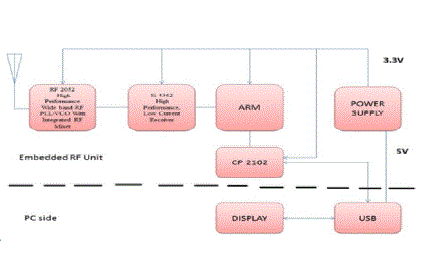 |
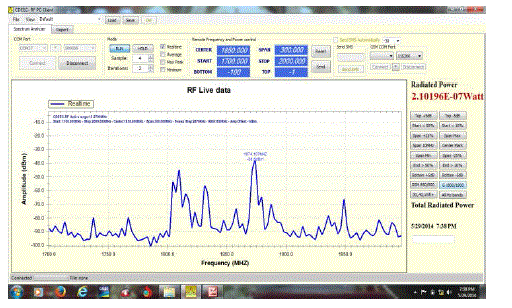 |
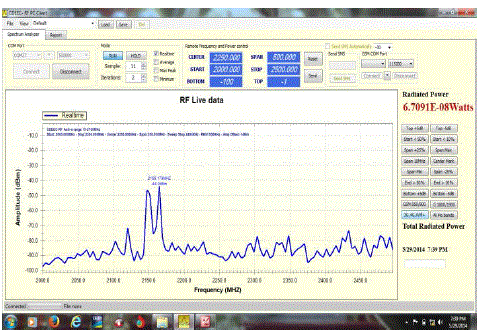 |
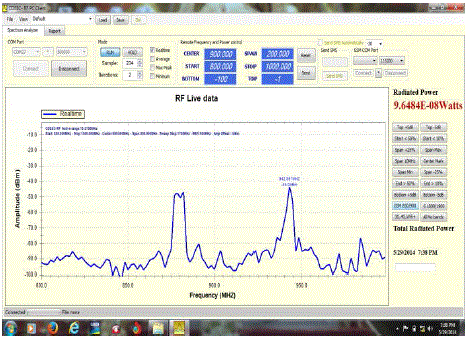 |
| Figure 1 |
Figure 2 |
Figure 3 |
Figure 4 |
|
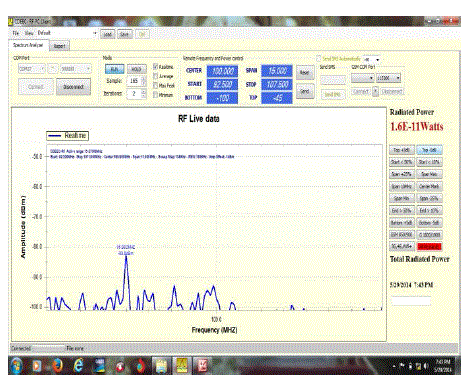 |
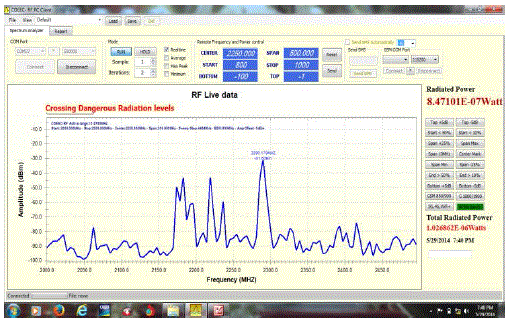 |
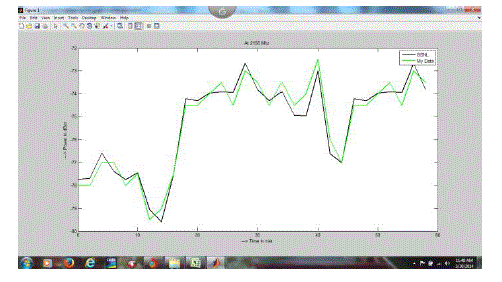 |
| Figure 5 |
Figure 6 |
Figure 7 |
|
| |
References
|
- REPORT ON CELL TOWER RADIATION Submitted To Secretary, DOT, Delhi
- Report on BVI Radiation Measurement Project
- Study of the Cell Towers Radiation Levels in Residential Areas (Proceedings of the 2013 International Conference on Electronics and Communication Systems)
- Installation and configuration: Horizon II macro cell report.
- Lurton Electronic; 3Axis Radio Frequency Electromagnetic Field Meter" Model: EMF-839.
- Lin, J.C., Cataracts and cell-phone radiation, Antennas and Propagation Magazine, IEEE2003, 45 (1), 171 – 174,
- Kesari, K.K.; Behari, J.; Effect of mobile phone radiation exposure on reproductive system of Male rats, IEEE2008, 564 – 567,
- Bio-initiative Report, A Rationale for a Biologically-based Public Exposure Standard For Electromagnetic Fields (ELF and RF), 2007, 2012
- Mobile Telecommunications and health research programme (MTHR) Report 2007
- N. Kumar and G. Kumar, “Biological effects of cell tower radiation on human body”, ISMOT, Delhi, India, pp. 678-679, Dec. 2009
- Real Time Monitoring System for Electromagnetic Radiation Measurements Using Arm Processor for Cellular Base Stations- International Journal of Engineering Research & Technology (IJERT) Vol. 1 Issue 4, June - 201SSN: 2278-0181
- Prescription for the measurement the electromagnetic fields generated by mobile phone base Stations, BUWAL and METAS, 28. June2002
- Prescription for the evaluation of electromagnetic fields near mobile phone and WLL-base Stations
- H. Lehmann, P. Fritschi and B. Eicher, Indoor Measurements of the Electrical Field close to Mobile Phone Base Stations, Proceedings of the General Assembly of URSI, Maastricht 2002.
- G. Wolfle and F. M. Landstorfer, “Field strength prediction with dominant paths and neural Networks,” in MIOP 1997, Sindelfingen, Germany, pp. 216 – 220, Apr. 1997.
- ICNIR Guidelines for limiting exposure to time varying electric, magnetic and electro-Magnetic fields up to 300 GHz.
-
|